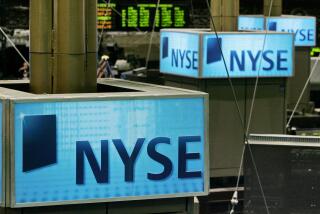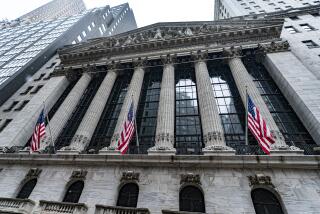Earnings Trend: It’ll Soon Come Out in the Wash
- Share via
Given the choice of thinking about Kosovo or about a new Jenn-Air refrigerator, Wall Street makes the logical decision every time.
As the bombs dropped in the Balkans last Thursday, Maytag Corp. shares helped lead a strong rally in the U.S. stock market after the company said first-quarter earnings will handily beat analysts’ expectations, thanks to surging appliance sales.
We knew that Americans were continuing to buy bigger homes at a brisk pace, and now we know what they’re putting in those big, empty rooms: massive Jenn-Airs with side-mounted freezers, energy-efficient Neptune washing machines and the newest Maytag innovation, the Gemini two-oven range.
All in all, Maytag said, sales in the first quarter will be up 5% to 7% from a year ago and earnings will be up 15% to 20%.
Investors responded by bidding Maytag stock up $5.94 to $60.25, an 11% one-day gain. The shares gained more ground Friday, closing the week at $60.56 on the New York Stock Exchange.
OK, that doesn’t look like much next to the latest Internet issue. But for a venerable old U.S. manufacturing stock, an 11% one-day gain is a veritable buying frenzy.
What Wall Street is hoping for in coming weeks are a few hundred more Maytag-like moments, as first-quarter corporate earnings reports begin to flood the news wires.
It has been tempting to argue that earnings don’t matter anymore, given the astounding valuations investors award to almost any untested Net company that puts its shares on the market.
But for the typical stock, underlying earnings--meaning earnings right now, not hoped-for, if-it-all-works-out-perfectly earnings five years down the road--still are paramount in determining what investors will pay for the shares.
Even those seemingly invincible blue-chip giants like Coca-Cola, whose stratospheric stock price-to-earnings ratios are largely responsible for making the market appear so drastically overvalued, aren’t impervious to bad earnings news.
Coke stock, in fact, has basically been dead money since mid-December as investors have fretted over the company’s weak results in many of its foreign markets.
The stock had been attempting a modest rally in recent weeks, but that ended last week when Merrill Lynch & Co. analysts trimmed their first-quarter earnings estimate for Coke to 31 cents a share from 32 cents and cut the full-year estimate to $1.45 from $1.50, citing fresh worries about overseas sales and earnings.
Coke, at $65.31 a share on Friday, may still be valued at a lofty 45 times Merrill Lynch’s 1999 per-share earnings estimate. But since July 1997, the stock price has fallen 5.5%, while the Standard & Poor’s 500 index has risen 34%.
(And pity the investors who paid the 52-week high price of $88.94 for Coke last summer. They’re 27% in the hole so far.)
Which company--Maytag or Coke--more accurately represents the overall tone of what first-quarter earnings of major U.S. companies will be like?
The earnings optimists are in the majority on Wall Street, which isn’t that unusual. (Analysts are paid to be optimistic, after all.) Boston-based First Call, which tracks analysts’ earnings estimates, says expectations point to a 6.7% average rise in S&P; 500 companies’ earnings in the first quarter versus a year ago.
That would be the strongest quarterly gain since the fourth quarter of 1997, which speaks volumes about how tough last year was, earnings-wise, for many American companies squeezed by tougher competition, rising labor costs and weaker export demand.
The problem with that average, of course, is that it’s made up of estimates for 500 companies. So by definition, many firms will do far better than 6.7% growth and many will do far worse.
The individual investor tracking a personal portfolio of blue-chip stocks might well say that that 6.7% figure, or any earnings average for that matter, is irrelevant. Even if that aggregate figure is realistic, it’s not going to help individual shareholders if their own companies fall short of the targets Wall Street expects them to meet or beat.
Still, the overall trend of earnings is important for a simple reason: The greater the number of companies whose profits are growing, the greater the number of stocks to potentially pique investors’ interest. And that’s what bull markets are made of.
The great disappointment in U.S. corporate earnings last year was in the manufacturing sector, a victim of the Asian economic crisis and its spillover effects.
As Don Hilber, economist at Wells Fargo & Co. notes, “For nearly a year, manufacturers have shed jobs while most every other sector of the economy has added them. Only domestic-serving industries like food processing and building materials have been able to expand. The rest of manufacturing faces either weak export markets or intense import competition.”
Now there are signs that key Asian economies may be poised to rebound. Rising stock markets across the region are saying so. Meanwhile, in Brazil, which devalued its currency in January and is facing recession this year, the central bank buoyed optimism last week by cutting interest rates for the first time since mid-December. The Brazilian stock market has risen 13% just since mid-March.
If demand for U.S. exports were to pick up even modestly this year, while American consumers continue their hefty spending pace on houses, cars and other big-ticket items, the scene could be set for a continuing rebound in U.S. corporate profits.
That is Merrill Lynch economist Bruce Steinberg’s view: He recently raised his estimate for total S&P; 500 earnings growth in 1999 to 7% from 4.7%.
Curiously, one of the stock market’s biggest bulls--Abby Joseph Cohen of Goldman, Sachs & Co.--last week cut her 1999 S&P; earnings estimate.
But that was largely because 1998 results for the S&P; companies came in below her expectations, Cohen said. Adjusting 1999 results accordingly, she still sees 7% earnings growth this year over 1998. And in her opinion, that will be enough to push the stock market modestly higher between now and year’s end. She forecasts about a 3.3% rise in the S&P; 500 index from here--not exactly an Internet-style gain, but a gain nonetheless.
Are the optimists just kidding themselves? First-quarter earnings reports should go a long way toward clarifying the outlook. What we know so far, according to First Call, is that fewer companies than normal have “pre-announced” their first-quarter results, like Maytag’s report last week. But of those firms that have pre-announced, a larger-than-normal 65% have warned that results will fall short of expectations rather than meet them or beat them.
For the bull market’s sake, let’s hope that many companies with good news have simply opted not to share it yet.
Tom Petruno can be reached by e-mail at tom.petruno@latimes.com.
More to Read
Inside the business of entertainment
The Wide Shot brings you news, analysis and insights on everything from streaming wars to production — and what it all means for the future.
You may occasionally receive promotional content from the Los Angeles Times.










